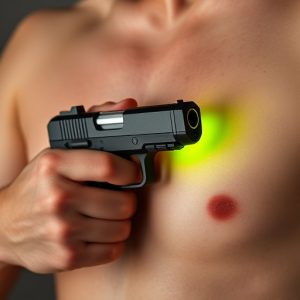Decoding Stun Gun Voltage: Factors Affecting Efficacy and Use
Stun guns are non-lethal self-defense devices that incapacitate attackers by delivering high-voltag…….
Stun guns are non-lethal self-defense devices that incapacitate attackers by delivering high-voltage electrical shocks. Contrary to popular belief, they do not always require direct contact with the skin to be effective; their electric current can leap across gaps due to a phenomenon known as air breakdown. The effectiveness of a stun gun is influenced by its voltage and amperage, as well as how the electric current is delivered and distributed on the body. Factors such as the target's physiology, hydration levels, clothing, and the environmental conditions can affect how a stun gun functions. It's important to understand that while higher voltages can intensify muscle contractions and neuromuscular incapacitation, they must be balanced with user safety and legal compliance. The design of the stun gun, including its contact probes, is critical for optimizing effectiveness in real-world situations. Users should consider manufacturer specifications and real-world experiences when selecting a model, keeping in mind that the legality of stun guns varies by location and should be adhered to strictly. This guide aims to provide a comprehensive understanding of stun guns' technical aspects, real-world application, and legal considerations for those considering them for personal defense.
Exploring the intricacies of stun gun voltage effectiveness, this article dissects the science and practical applications behind these devices. Delving into the question of whether a stun gun has to touch skin to be effective, we examine how voltage plays a pivotal role in their operation. We’ll analyze the factors influencing their performance, compare theoretical voltage ratings with real-world effectiveness, and address critical safety considerations and legal aspects. Join us as we unravel the complexities surrounding stun gun efficacy for a clearer understanding of their use and limitations.
Understanding Stun Gun Voltage: The Science Behind Effectiveness
Stun guns are electronic devices designed for self-defense, incapacitating attackers by delivering a high-voltage, low-ampere electrical shock. The effectiveness of a stun gun is primarily determined by its voltage output and the capability to induce muscle contractions or neuromuscular incapacitation without causing significant harm. While there’s a common misconception that stun guns must directly contact the skin to be effective, this isn’t entirely accurate. The electric current emitted from a stun gun can jump across a small gap, known as air breakdown, allowing it to still deliver a shock when not in direct contact with the target.
The science behind stun gun effectiveness revolves around electro-galvanic stimulation and neuromuscular responses. A stun gun operates by passing a high-voltage current through the body of an attacker, causing rapid muscle contractions and disorientation due to the interference with the brain’s electrical signals. The voltage level is critical because it determines the intensity of the muscular response. Higher voltages can lead to more pronounced effects, potentially including temporary paralysis or loss of balance and coordination. However, the threshold voltage required for incapacitation varies among individuals due to differences in body composition, hydration levels, and the presence of any insulating clothing. Thus, while the higher the voltage the better the potential effectiveness, it is not a definitive measure; other factors such as amperage, current delivery, and target characteristics also play significant roles. Understanding these aspects ensures a clearer grasp of how stun guns work and their effectiveness in self-defense situations.
The Impact of Skin Contact on Stun Gun Performance
When evaluating the efficacy of stun guns, the nature and extent of contact with the target’s skin play a critical role in their performance. For a stun gun to deliver its intended shock, it must establish an electrical circuit between the probes and the person being incapacitated. Direct contact with dry skin is often most effective, as moisture can impede conduction. The intensity of the voltage does not solely dictate the device’s ability to incapacitate; the manner in which the current passes through the body is equally significant. Factors such as the distance between the probes and the resistance of the skin can affect how well a stun gun functions. It’s a common misconception that a stun gun must touch skin to be effective; however, while direct contact maximizes the device’s shock delivery, it can still be effective when used against bare or lightly clothed skin, albeit with varying degrees of success depending on the aforementioned factors. Understanding these dynamics is crucial for law enforcement and self-defense situations where the quick and accurate use of a stun gun could be lifesaving or critical for apprehension. Thus, users must be trained to apply stun guns effectively, considering the variability in skin contact and conditions that can influence their performance.
Key Factors Affecting Stun Gun Efficacy Beyond Skin Contact
Stun guns are widely recognized as non-lethal self-defense tools, and their efficacy is a critical aspect for users to understand. Beyond the basic requirement of skin contact, several factors significantly influence a stun gun’s ability to incapacitate an assailant. The voltage of a stun gun, for instance, plays a pivotal role; higher voltages can deliver more powerful shocks, increasing the likelihood of neutralizing a threat. However, it’s not solely about the voltage—the duration and pattern of the electrical pulses are equally important. A consistent and rapidly pulsating current is more effective in inducing muscle spasms and disorienting an attacker than a steady, lower-intensity flow.
Furthermore, the design and construction of the stun gun, including the electrode configuration and energy storage capacity, are key factors. A well-designed stun gun should have a delivery system that can effectively penetrate through clothing to make contact with the skin, as the effectiveness is not solely dependent on direct skin contact. The design must also consider the safety of the user and bystanders, ensuring that the electrical discharge is contained within the intended boundaries. Understanding these factors is essential for users to select a stun gun that meets their self-defense needs effectively. It’s important to note the manufacturer’s specifications and customer reviews to gauge the real-world performance of a particular model. Users should also be aware of local laws and regulations governing the use of stun guns, as these can vary by region.
Comparative Analysis: Voltage Ratings and Real-World Stun Gun Use
When evaluating the effectiveness of stun guns, a comparative analysis of voltage ratings and their application in real-world scenarios is crucial. Stun guns are designed to incapacitate an assailant by delivering a high-voltage electric shock, which can cause neuromuscular incapacitation without causing long-term injury. The voltage ratings advertised for stun guns typically range from 450,000 to over 1 million volts. However, the actual output voltage upon deployment is often much lower. It’s a common misconception that stun guns must physically touch the skin to be effective; in reality, the electrical charge can pass through clothing in many cases, although contact does enhance their effectiveness by providing a more direct path for the current.
In practice, real-world use of stun guns has shown that their voltage plays a significant role in their performance. Higher voltage ratings correlate with the potential to deliver stronger shocks, which can be more effective in deterring an attacker or subduing them until law enforcement arrives. It’s important for users to understand that the effectiveness of a stun gun is not solely dependent on its voltage; factors such as the design of the device, battery strength, and proper technique are equally critical. Additionally, user-specific considerations, like the type of clothing worn by the target and environmental conditions, can influence the outcome of using a stun gun. Understanding the interplay between voltage ratings and real-world efficacy is essential for anyone considering a stun gun for personal safety.
Safety Considerations and Legal Implications When Using Stun Guns
When considering the use of stun guns for personal defense, safety and legal compliance are paramount. A stun gun’s effectiveness is contingent upon its voltage and amperage; typically, higher voltage and lower amperage deliver a more potent shock while minimizing the risk of serious injury to an assailant or bystander. However, it’s a common misconception that stun guns must physically contact the skin to be effective. Some models can deliver shocks through clothing, although their efficacy may vary depending on the thickness and material of the barrier. Users should familiarize themselves with the specifications of their device to understand its capabilities accurately.
Legal implications are another critical aspect when using stun guns. Laws governing their possession and use differ by jurisdiction; therefore, it’s essential to verify local regulations before acquisition and use. In some regions, there may be restrictions on who can legally own a stun gun, where they can be carried, and under what circumstances they can be used. Additionally, the use of stun guns comes with inherent risks, such as the potential for overuse or misuse in situations that do not threaten life or serious bodily harm. Users must exercise judgment and discretion to comply with both the letter and spirit of the law, ensuring their safety and the safety of others around them. Understanding these legal and safety considerations is crucial for responsible stun gun ownership and use.


